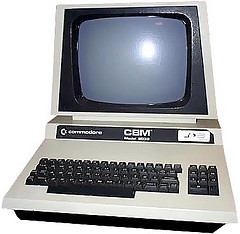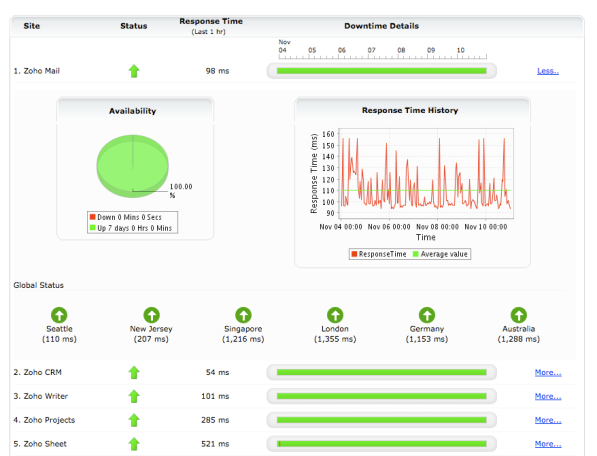
Courtesy of site24x7 by Zoho. Thanks to my host, PressHarbor.
Connecting the dots ...


Courtesy of site24x7 by Zoho. Thanks to my host, PressHarbor.

 Just a short note:
Just a short note:
Guess who will welcome GooGreed with a big smile? Zoho.
Update: TechCrunch has the clarification from Google:
In experimenting with a number of different landing page layouts, the link to Standard Edition was inadvertently dropped from one of the variations. We are in the process of restoring it and you should see it soon. We have no intention of eliminating Google Apps Standard Edition, and are sorry for the confusion.
Related posts:

Two recent posts by Enterprise Social Software vendors Jive and Atlassian set up a huge debate amongst my fellow Enterprise Irregulars. Here’s the money-quote from Jive:
It’s not so long ago that it felt embarrassing to say the words "SaaS" and " single-tenant" in the same sentence. For years, it’s been an industry mantra that it’s simply impossible to have a scalable SaaS business without multi-tenancy.
Both Jive and Atlassian went single-tenant. That’s a red flag with many SaaS purists. But there’s more then just tenancy. What if customer data stays behind the firewall, while the application is still provided over the web? Is that still considered SaaS? Do customers really care about such issues, or do they look for innovation in features and services?
And a bonus: the #1 SaaS icon supposedly delivers on-premise, if the deal is big enough…

 One of the major roadblocks to SaaS providers’ entry to the enterprise is IT and Business concerns about corporate security, thinking of the firewall as the last line of defense.
One of the major roadblocks to SaaS providers’ entry to the enterprise is IT and Business concerns about corporate security, thinking of the firewall as the last line of defense.
Microsoft SharePoint has a very strong position in the Enterprise as the incumbents behind-the-firewall collaboration server, and for years smart Collaboration and Social Software vendors with better functionality, like Atlassian, Socialtext, Jive Software, Newsgator have been "playing well", adopting their services to SharePoint.
Now Zoho joins, announcing Zoho Office for Microsoft SharePoint, which combines the benefits of a collaborative SaaS Suite with the (perceived or real?) security if keeping data behind the firewall.

 Ma.gnolia, a social bookmarking service is down, lost all their user data and they don’t know if / when they can recover.
Ma.gnolia, a social bookmarking service is down, lost all their user data and they don’t know if / when they can recover.
This is as bad as it can get for any Web 2.0 service (and more importantly for users), and the backlash against Cloud services has already started. My first reaction is taking Stowe Boyd’s approach – a quick overview of how safe my own data is.
Update: also read Krish’s post @ ClouDave: Magnolia Effect – Should We Trust The Clouds?

InfoWorld announced the winners of the 2009 Technology of the Year Awards in Applications, Middleware, and Data Management:
The Awards are presented in a slideshow format, and InfoWorld made it almost unreadable: there is an ad in between every single page, you either 20 second to flip a page, or have to click “skip” every single time, then click one more time to close another page that hides the slide. Frankly, I think they went way overboard with this.
That said, I did the work for you, here are the winners:
Congratulations to the winners!
(Cross-posted from CloudAve)

One down, one running better than ever. Thanks to the irony of TechMeme, the two news are juxtaposed almost side by side:
 Stopping development on Google Notebook – as several blogs point out, this does not mean Google Notebook is dead. You can continue to use it as your scratch-pad, just don’t expect any further development. (Update: you won’t be able to use the web-clipping Firefox extension anymore.) Or if you’re cautious, start migrating your notes.
Stopping development on Google Notebook – as several blogs point out, this does not mean Google Notebook is dead. You can continue to use it as your scratch-pad, just don’t expect any further development. (Update: you won’t be able to use the web-clipping Firefox extension anymore.) Or if you’re cautious, start migrating your notes. of enhancement on the very same day Google sent theirs to the deadpool. Kent Newsome calls it Zoho’s Lucky Day.
of enhancement on the very same day Google sent theirs to the deadpool. Kent Newsome calls it Zoho’s Lucky Day.I’ve never considered these two Notebooks comparable, despite the common name. Google’s one was your web-based post-it notes, barebones, easy to use. Zoho’s version is a full-featured multimedia application to create, aggregate, share, collaborate on just about any type of content easily, be it text, database, spreadsheet, image, drawings, audio, video – you name it. It offers a lot more, but may be “too much” if all you want is the yellow stickies. The two apps serve entirely different needs. But I don’t want to focus on the products here, did it before: Not All Notebooks Are Created Equal.
Let’s talk about the economics: Google is simply ditching some of the money losers which is clearly the right strategy in a recession when it saw it’s primary revenue source, advertising drop radically. A while ago (before the economy collapsed) Zoho CEO Sridhar Vembu provided great insight into why getting into applications does not make much financial sense for Google, whereas it is Zoho’s primary business. Today we’re seeing that logic in action.
Of course Google is not the only one, we’re seeing startups shut down service, or give up the free-for-all principle and start charging for their services. Over at CloudAve we’ve discussed Jott as an example, but there are many others. We may have enjoyed all these free services, but deep down had to predict this bonanza would not last forever. It’s time for rationalizing business – after all, it’s all about making a buck.
Update (1/20/09): Surprise, surprise! (not really). Zoho came out with a tool to import your Google Notebook data into Zoho Notebook.
Update (1/22/09) Two days later here comes Evernote with an import process. Who’s next?


I’ve written about Zoho Creator before – being techno-challenged myself, the key value for me (and I suppose for millions of potential users) is the ability to generate database driven situated applications without the need for any programming. Zoho CEO Sridhar Vembu made an interesting statement back in April:
In principle, it would be possible to layer Zoho Creator on top of Google App Engine on top of Amazon EC2.
Well, it’s no longer just in principle: today Zoho announced the ability to use Zoho Creator to generate applications which are then deployed on Google’s AppEngine. Here’s a short video explaining the process:
The video focuses mostly on the process of how to create an app, convert it from Zoho’s own Deluge scripting environment to Python, then installing it on the Google AppEngine. You will get more detailed explanation elsewhere, let me just focus on why I find this an important step.
Zoho essentially expands Google’s reach, making it available to users without programming skills. It’s a perfect marriage: Zoho brings the ability to create programs without coding in a user-friendly graphical environment, while Google brings security for those who might worry keeping their apps and data with a smaller provider: now they can use the Zoho-generated apps in the safety of GoogLand.  .
.
The other important aspect is portability, and to quote Zoho’s Raju Vegesna, first they let data be free by releasing CloudSQL, and now they let your applications free.
We’ve already seen Zoho adapt Google Gears first, even before Google Apps; this is now another example of friendly coopetition with Google.
(Disclaimer: Zoho is the exclusive Sponsor of Cloudave, my main blogging gig.)
Related posts:

 How old is your work computer? – asks the Wall Street Journal.
How old is your work computer? – asks the Wall Street Journal.
Mine is a year-and-a half old. The dual-core former screamer (obviously not the one the the pic to the right) has become an average slow machine now that quad-core is the standard, but I could not care less. I don’t need a faster, bigger computer for work, in fact not even for video-conferencing or watching movies.
In fact I (and most of us) don’t even need 1-2 year-old computers, either, now that browser is the computer.
Now, you’ve heard this a zillion times, but let me present another side: the more you use your computers, the slower they get. In fact it gets worse: you don’t even have to use your computers, they get slower by themselves.
Why, and more importantly, what’s the solution? Read the full article on CloudAve – while at it, might as well grab the feed here. 

No service is a 100% available, and of course your SaaS provider’s outage always comes in the ‘worst time’, just when you have a deadline to meet… what really gets painful is when you have no information whatsoever on what just happened and how long the outage may be. Major providers like Salesforce.com and Amazon learned the lesson the hard way, and they both released their status dashboards after extended outages and the customer uproar that followed:
Free services rarely display such level of transparency, but that’s exactly what Zoho is announcing today: they created Zoho Status , a monitoring service which displays the health of all Zoho Applications – currently 24. Here’s a partial screen-print:

 If it looks familiar, perhaps you followed my earlier advice on using Zoho’s Site24×7 service on your own site or even blog. I’ve been using it for two years now, and received alerts of outages that neither I nor my service provider were aware of.
If it looks familiar, perhaps you followed my earlier advice on using Zoho’s Site24×7 service on your own site or even blog. I’ve been using it for two years now, and received alerts of outages that neither I nor my service provider were aware of.
Zoho took their own tools and turned it into a public availability display, monitoring their services from six different locations: Seattle, New Jersey, Singapore, London, Germany and Australia. For now the display is rather “boring”, being all green. Obviously we’re all better off if it stays that way and we have no reason to check the status site.
What makes sense, however, is to use Site24×7 on your own site, or on any service you are dependent on (you don’t have to install anything, it’s all external monitoring). As usual, it starts with a free level, adding extra paid services – the new addition today is the Enterprise version, allowing SLA definition, compliance tracking and reporting.
Related articles:
(This article is cross-posted from for CloudAve, the Zoho-sponsored Cloud-Computing / SaaS / Business Blog I am editing. Subscribe to our feed here.)


Publisher / Editor of CloudAve and Enterprise Irregulars.
I do most of my business blogging there, with occasional asides here. More...
Copyright © 2025 · Mindstream Child Theme on Genesis Framework · WordPress · Log in
Recent Comments